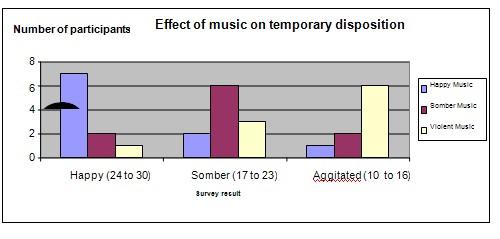| Complexity level: | 5 |
| Project cost ($): | 30 |
| Time required: | 1 day for preparation, 1 day for observation |
| Material availability: | Easily found |
| Safety concerns: | None |
Hypothesis
The type of music being played in the background will affect the temporary disposition of the participants.
Overview
Music and moods
Music has been around for ages and is not limited to any culture or nation. It has been called an international language as one does not have to speak the language in order to appreciate a culture’s music. All cultures, religions and nations have some form of native song, music or instrument that is part of their tradition.
The reason music is popular in all cultures is because of the soothing effect it has on people. Listening to soft music and enjoying it can help to alter a person’s mood and bring a certain contentment, joy and happiness in them. This can be very useful in helping to lift our spirits at times when we are feeling down, disappointed or depressed.
Music can help in reducing stress by helping our muscles to relax, while reducing our breathing rate. It also stimulates the production of the hormone serotonin that makes us feel happy and improves our mood. Music is also able to elevate our moods by altering our brain waves. Fast, motivational music can be useful in getting our adrenalin pumped so that we will be motivated during exercise or work.
Scientific Terms
Materials
The materials required for this science fair project:
- 30 participants, each 12 years old
- A cheerful, happy music CD (e.g. upbeat children’s songs)
- A somber music CD (e.g. opera music)
- A heavy-metal music CD
- A CD player
- A classroom
- Tables and chairs
Procedure
1. For this science fair project, the independent variable is the type of music played in the background. The dependent variable is the temporary disposition of the participants. This is determined by having them each complete a survey form. The constants (control variables) are the number of questions asked and the length of time the music is played.
2. Prepare a survey form to help evaluate the emotions, moods and temporary dispositions of the participants. An example of the survey form is shown above. There are also commercially available surveys which can be acquired for the purposees of this experiment. Make 30 copies of the form.
3. Separate the participants into 3 groups of 10 persons each. Bring only one group into the classroom at a time. When the 1st group enters the classroom, play the cheerful music in the background for 1 hour before having them fill up the survey form. Play the somber music for the 2nd group and the violent music for the 3rd group.
4. After each group of participants has completed the survey form, collect the forms and total the points for each participant. Separate them into the following categories: Happy (24 to 30 points), Somber (17 to 23 points) and Violent (10 to 16 points). Record your results in a table, as shown below.
| Temporary disposition survey | Group : 1 / 2 / 3 | Total points : | ||
| Name | Age | Gender | Select one of the following emotions | |
| No. | Condition | 1 Point | 2 Points | 3 Points |
| 1 | Normal state | Angry | Moody | Happy |
| 2 | Something is lost or misplaced | Frustrated | Anxious | Relaxed |
| 3 | Getting scolded | Angry | Hopeless | Relaxed |
| 4 | Receiving a gift | Excited | Calm | Happy |
| 5 | Failure to complete a task | Frustrated | Hopeless | Willing to try again |
| 6 | Successful in completing a task | Excited | Calm | Happy |
| 7 | Receiving praise | Excited | Calm | Happy |
| 8 | Being cheated | Angry | Somber | Relaxed |
| 9 | Winning a contest | Excited | Calm | Happy |
| 10 | Scoring top grades | Excited | Calm | Happy |

Results
It was observed that the temporary disposition of the participants was somewhat altered according to the type of music they had been listening to before taking the survey.
| Music listed to prior to the survey | Effect of music on participant’s disposition | ||
| Happy (24 to 30) | Somber (17 to 23) | Aggitated (10 to 16) | |
| Cheerful Music | 7 | 2 | 1 |
| Somber Music | 2 | 6 | 2 |
| Heavy Metal Music | 1 | 3 | 6 |
The above results were then plotted onto a graph, as shown below.

Conclusion
The hypothesis that the type of music will affect the temporary disposition of school students, has been proven to be true.
Music can help calm a person, reduce stress, making them happier and more motivated. However, for this to happen, the person listening to the music must enjoy the music. If the listener does not like the music being played, the effect on the listener mayinstead of negative.
Also consider
The science fair project may be repeated to find out the effects of specific genres of music on mood, such as classical, jazz or country music.
The experiment can also be done to compare the effects of music on different genders and age groups.
References
How music affects your mood - http://www.essortment.com/all/musicaffectmoo_rwdj.htm
Using music to change your mood - http://www.2knowmyself.com/Music_therapy/changing_your_mood_using_music_stress
The effects of music on temporary disposition - http://clearinghouse.missouriwestern.edu/manuscripts/260.php

